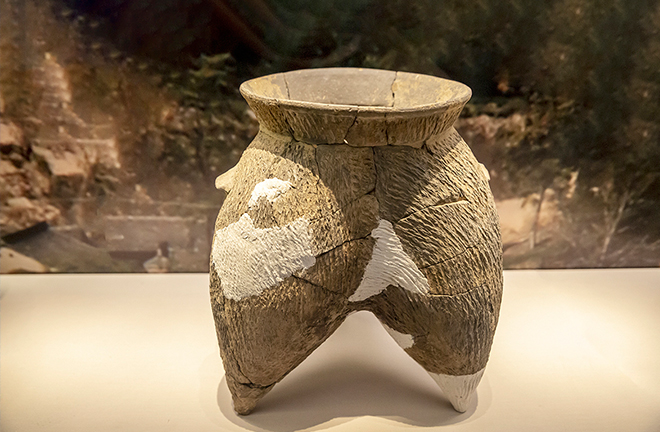Scholars reveal early civilizations in river basins

A pottery vessel of the Taosi culture, dating back to 2,300–1,900 BCE, displayed at the National Museum of China in Beijing Photo: CFP
In recent years, significant breakthroughs have been made in cultural heritage and archaeology, with many relating to great river basins.
Dynamic evolution
Early civilizations and settlements around the world tended to originate in and around the great river basins. The development of civilizations in these areas closely indicates the evolution of the man-land relationship. Wang Fang, a professor from the College of Architecture and Landscape Design at Peking University, noted the necessity of exploring the environmental context behind the historical development of settlements and the origins of civilizations, as well as the evolutionary mechanism of the human-water relationship, which could lead to a better understanding of the adaptability and sustainable development of settlements in river basins.
“Settlement sites in river basins epitomize ancestors’ adaptation to and transformation of nature, embodying the close connection between social development and environmental changes,” said Wang Changsong, a research fellow from the Institute of Historical Geography at the College of Urban and Environmental Sciences at Peking University. The development of settlements was influenced more by the environment in earlier stages, but probably more by policy in modern times. Traditional villages have a long history of adaptation and development, while the evolution of non-traditional villages also deserves further studies.
“As a critical unit of archaeological research, river basins feature dynamic and complex natures,” said Gao Chenge, an associate professor from the College of Architecture at Taiyuan University of Technology. Academic discussions on heritage sites have expanded from the heritage itself to heritage and its surrounding area’s topography, hydrology, infrastructure, and other material elements, as well as the social, economic, cultural, and other non-material elements. Scholars have shifted focus from the object of heritage to the perception of the subject and the interaction between the two sides, transitioning from previous static heritage to its dynamic evolution. This philosophy based on historical accumulation and dynamic space-time has gradually developed into a methodology of heritage protection.
Early settlements
“The human-land relationship of early civilizations and settlements in river basins is a significant archaeological topic,” said Zhang Changping, a professor from the School of History at Wuhan University. From supporting the generation of cultural individuality to acting as channel for facilitating cultural exchanges, river basins allow us to better understand cultural diversity and the need for cultural communication, and are of great importance for our understanding of early civilizations.
The sites of China’s early civilizations were mainly distributed along great rivers in chain-like structures, such as the Taosi site in Shanxi Province and the Shimao site in Shaanxi Province along the Yellow River chain, and the Liangzhu site in Zhejiang Province along the Yangtze River chain. In Wang Fang’s view, civilizations bred in river basins met with varying challenges and opportunities at each stage of social development, such as the human-water relationship during emerging social complexity, cultural responses under dramatic environmental changes, the development of caoyun [special canals for transporting grains to the court], changes in the distribution of river basins and settlements, as well as the preservation, development, and utilization of settlement sites in the context of modern urbanization.
“The prehistoric culture in the middle reaches of the Yangtze River, exemplified by the Shijiahe ancient city site, has witnessed high-level development,” said Fang Qin, president of Hubei Provincial Institute of Cultural Relics and Archaeology. The Shijiahe settlements are comprised of three periods, namely the Tanjialing city, the Shijiahe city, and the Xiaojiawuji culture. During the Xiaojiawuji culture period, about 4,200–3,800 years ago, the Central Plains civilization arrived here. The settlements expanded eastwards to the Zhangjiawan site in Dawu County in Hubei Province, where exquisite jade artifacts were found, showcasing the integration with the Central Plains civilization and contributing to the formation of the Chinese civilization that features unity in diversity. Changes in Shijiahe settlements not only epitomize the process of Chinese civilization’s pluralistic integration, but also the integration of the Yellow River and the Yangtze River civilizations into a cohesive Chinese civilization.
The vegetation in arid western China is composed mainly of desert and grassland, primarily replenished by alpine melt water. Shui Tao, a professor from the School of History at Nanjing University, said that the human-land relationship and early civilizations in Xinjiang have been mainly investigated using oasis, highland, and river basin models. Bronze Age cultural relics from around 2,000 BCE have been found in various parts of Xinjiang, such as Xiaohe culture, Tianshanbeilu culture, and the Adunqiaolu site. Due to regularities revealed by archaeological findings in Afghanistan, Central Asia, Iran, and other places, it is believed that evidence of the existence of early culture can also be found in the river valley environment in the piedmont areas of the Tarim River basin.
According to Pauline Sebillaud, an associate professor from the School of Archaeology at Jilin University, from 2012 to 2016, the Research Center for Chinese Frontier Archaeology of Jilin University conducted regional surveys around the Yueliangpao and Xinhuangpao lakes west of the Nenjiang River in northwestern Jilin Province. The surveys uncovered historical remains dating as far back as 10,000 BCE to the late Qing Dynasty (1644–1911) and the Republic of China (1912–49), revealing the forms and evolution of regional settlements around the Yueliangpao Lake waters in different historical periods.
Edited by YANG LANLAN
